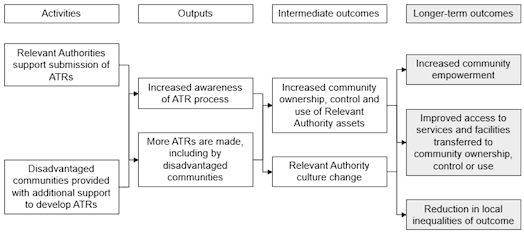Community Empowerment (Scotland) Act 2015: asset transfer requests - evaluation
Findings from an independent evaluation assessing the implementation of Part 5 of the Community Empowerment (Scotland) Act 2015 – asset transfer requests. The evaluation was commissioned by the Scottish Government and was conducted by researchers at Glasgow Caledonian University.
1. Introduction
This report presents findings from an evaluation of Part 5 of the Community Empowerment (Scotland) Act 2015 (the Act). Part 5 of the Act relates to asset transfer requests (ATRs) and it gives community transfer bodies (CTBs) the right to request to buy or lease assets from relevant authorities (RAs). Whilst asset transfer is not a new process, the legislation opens up new opportunities for communities. It enables communities to take on public sector land and buildings while placing new responsibilities on relevant authorities to respond to their requests in a transparent and timely way.
Part 5 of the Act came into force on 23 January 2017. Following its implementation, the Scottish Government wants to understand more about the ways in which this new provision has been implemented by relevant authorities and used at a local level, and the impact that Part 5 is having. Accordingly, in 2018 the Scottish Government commissioned a team from the Yunus Centre for Social Business and Health, Glasgow Caledonian University, to undertake an evaluation to answer the following research questions:
1. Whether, how and to what extent, is Part 5 of the Act being implemented as intended in the legislation and guidance?
2. To what extent does implementation of Part 5 of the Act result in more asset transfers being initiated and assets being transferred to community ownership, control and use, and with what potential contribution to improved access to transferred services and facilities?
3. What is the pattern of take up and use of Part 5 of the Act among different community groups? What are the potential implications of these patterns for local inequalities of outcome?
4. Whether, how, and to what extent do communities feel more empowered as a result of the availability, take up and use of Part 5 of the Act?
The evaluation was informed by a previous study conducted by Myers, Geyer and Craig (2017)[3], who assessed the evaluability of Part 5 of the Act and developed a Theory of Change model (Figure 1) to describe how the implementation of Part 5 of the Act might contribute to change. This model identified key activities, outputs, and intermediate and longer-term outcomes relating to Part 5 of the Act. The stages of this evaluation correspond with different components of Myers et al.’s Theory of Change and also informed the thematic framework used to analyse the data (discussed in Section 3).

Source: Myers et al. (2017)
The report is structured as follows: Section Two outlines the background to asset transfer requests; Section Three details the methodological approach undertaken for this evaluation; and Section Four outlines the implementation of asset transfer requests (addressing research questions 1 and 3). Section Five reports on asset transfer request activity and trends (research questions 1 and 3) and Section Six details findings related to intermediary outcomes of Part 5 of the Act (research question 2). Section Seven outlines evidence pertaining to longer-term outcomes of Part 5 of the Act (research questions 2 and 4). Section Eight presents an example of a completed asset transfer request, Blantyre Soccer Academy. A discussion surrounding the revised Theory of Change model is given in Section Nine. Recommendations, conclusions and limitations are presented in Sections Ten, Eleven and Twelve, respectively.
Contact
Email: socialresearch@gov.scot
There is a problem
Thanks for your feedback